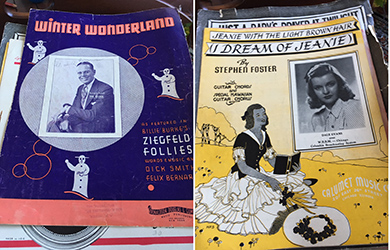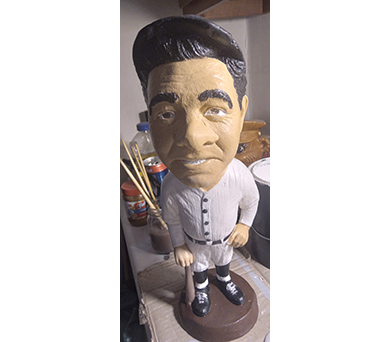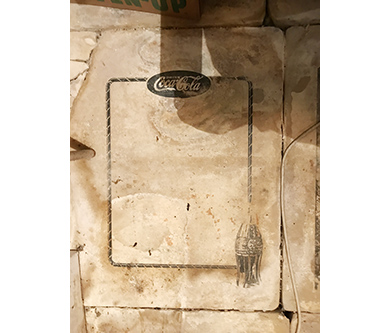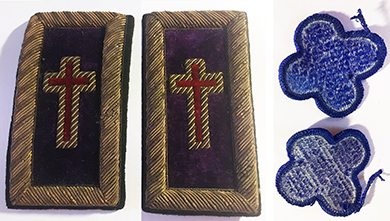 |
|
|||
 |
 |
|||
RINKER ON COLLECTIBLES — Column #1775 Copyright © Harry Rinker, LLC 2021 Questions
and Answers
QUESTION: I recently inherited a collection of piano sheet music, most dating from the 1940s. I have gone through the pile and discarded the most deteriorated sheets. I am down to slightly over 77 individual pieces of sheet music and about 25 books of piano music. A sampling of the sheets includes Stephen Foster’s “I Dream of Jeanie,” the cover of which features a photograph of a young Dale Evans, “A Dream” by J. C. Bartlett with a romantic image of a woman with her head on a pillow; “Just A Baby’s Prayer at Twilight;” and, “Winter Wonderland” with a cover photograph of Don Bestor (orchestra leader). The latter song was a featured song by Billie Burke in the Ziegfeld Follies. I did some research and am amazed at the dollar amounts asked for some sheet music. What advice can you provide as to the value of my collection? – VM, Email Questions 
ANSWER: There are two non-collecting issues that frame this answer. First, the sale of home-based pianos has been steadily decreasing as fewer and fewer individuals wish to learn to play the piano. Second, the secondary antiques and collectibles market is flooded with used pianos, most of which never find a buyer. Your books of piano music have little monetary value, at best a dollar. My recommendation is to contact a local piano teacher, assuming there still is one in your area, and offer to give the books to the person free of charge for distribution to his/her students. Do not be surprised if your offer is turned down. You may have to persist. If this fails, try contacting a local high school or college/university that still has a music program. Again, do not get discouraged by a “not interested” response. The value of your music sheets rests primarily with crossover collectors, those individuals buying the sheet music for the cover art image rather than the music. Assuming this is true, it means you maximize your return by selling the sheets separately, a time consuming and labor-intensive process. You took the correct first step in discarding the damaged sheets. Sheet music buyers want sheets in fine or better condition. Decorators want sheets in frameable condition. Based on the images that accompanied your email, you did not go far enough. In one image, someone used masking tape as a resale price sticker. It cannot be removed without damaging the sheet. In another image, an owner of the music sheet signed his name across the center of the sheet, a factor that lowers the perceived value of the sheet. Finally, asking prices on the internet are not getting prices. Even a sell through price is not a guarantee that the next example will sell through at that price or better. My recommendation is to sell the 77 sheets as a lot – take them all or not at all. An asking price of $20.00 should result in a sale, albeit you may have to work hard and be patient to obtain it. Asking more will most likely result in your not selling the lot. The alternative is to pick out the best five to seven sheets from the lot and try to sell them individually at half the asking value of identical sheets being offered for sale on eBay. It always makes sense to undersell the competition if you want to sell something quickly. As with any lot of material, the majority of the value (80 percent or higher) rests in the top 10% of the items. QUESTION: I recently acquired a chalkware statue of Babe Ruth. It is 18-inches tall and weighs almost nine pounds. I repainted it, which may have been a mistake. What insights can you provide? – RK, Newark, OH, Email Question 
ANSWER: ESCO (Entertainment Statue Company) was responsible for the “Big-Headed” statues that graced American bars/taverns and steak houses during the 1970s and 1980s. Statue subjects ranged from Humphrey Bogart to W.C. Fields, from Frank Sinatra to Babe Ruth. Historical information regarding ESCO is sketchy. Most sources identify it as a New Jersey Company that began in the 1970s. A post on a collector’s forum stated that the firm was located on 59th Street in Brooklyn’s Borough Park neighborhood. Although best known for its 1970s and 1980s statues, ESCO continued to produce “Big-Head” statues into the 1990s and early 2000s. ESCO never licensed any of its statues, often producing images of individuals who were deceased. Small batches were created to avoid copyright litigation. Over 85 different statues of movie, music, television, and sport celebrities, notable cultural figures, and character figures have been identified. The figures were made of plaster of Paris built around a wire skeleton. Most exceed 16-inches in height and weighed between eight and nine pounds. The ESCO statues are cousins to carnival chalkware, which is much lighter in weight and cast without interior support. ESCO statues were marketed in tobacco shops, novelty stores, and through bar and restaurant wholesalers. Bob Hope, Laurel and Hardy, Groucho and Harpo Marx, and the Three Stooges were among the most popular ESCO figures. More recent statues included Al Capone and Bill Clinton holding a sax. Other companies copied ESCO’s “Big Headed” style. ESCO statues were painted with great care and skill, especially given their chintzy nature. The statues were prone to chipping, meaning that when found most need to be repaired and often repainted. There are several companies such as ESCO Artist Painter & Repairman (www.escostatues.com) that specialize in restoring ESCO statues to their period appearance. Collectors identify your repainting as an “amateur” restoration. Collectors pay top dollar only for period pieces with no paint damage or with repainting by a skilled professional. The images that accompanied your email suggest you did an excellent job repainting it but did not match the period colors exactly. You used a thick paint which masked some of the statue’s period detail. The value of your statue as it now stands is between $150.00 and $175.00. QUESTION: I recently came across a number of concrete stones in the basement of an old house. They measure about 18-inches by 30-inches by 1 1/2-inches. One contains a positive image of Coca-Cola poster border, a second a positive advertising image for US Royal Tires, and a third for Koerber’s Beer. Images on the other stones are too worn to read. What can you tell me about them? – NP, OH, Email Question 
ANSWER: Upon receiving NP’s email, I responded and asked him to look at the surfaces of the stones and tell me if they were rough or smooth in texture. When he responded that they were smooth, I knew what was used to create the basement floor. The floor is made of large lithographic stones. Lithography was done by drawing an image with oil, fat, or wax onto the surface of a smooth, level lithographic limestone plate. The stone was treated with a mixture of acid and gum Arabic, etching the stone in the areas not protected by the greased based image. When wetted, the stone’s etched areas retained water. When an oil-base ink was applied, it stuck only to the original drawing. The ink would finally be transferred to a blank sheet of paper. There is a viable secondary market for old lithographic stones. Most are much smaller in size than those found on the basement floor. Although faded, the Coca-Cola and Koerber Beer (Toledo, OH) stones would find ready buyers among Coca Cola collectors and Koerber Beer collectors, especially given the one-of-a-kind nature of the surviving lithographic stone. A rough estimate of the retail value of the Coca-Cola stone is between $125.00 and $150.00. The Koerber Beer stone would sell for less, most likely between $75.00 and $100.00. An auction bidding war between several dedicated collectors could easily result in a much high price. QUESTION: In a box lot I recently acquired at an auction, I found a number of military patches. All are sewn onto leather backings. The first is a shoulder board with a cross, possible a chaplain’s badge. The second is a four-leaf blue clover. The third has a stack of three arrow points on khaki. I would like to know what they are. – LC, Fountaintown, IN, Email Question 
ANSWER: My son Harry Jr. is a military collector and reenactor. I forwarded your email to him. First, he noted that the shoulder boards with the cross are not military but fraternal, possibly Knights Templar. I double checked and found he was correct. Historic examples retail between $20.00 and $25.00 for a pair. The blue clover patch is from the 88th infantry division. During World War II, the 88th infantry was ordered into active military service on July 15, 1942, at Camp Gruber, Oklahoma. It was sent overseas to Europe on December 6, 1943. It was involved in campaigns in the Rome-Arno, North Apennines, and Po Valley. It was deactivated on October 24, 1947 in Italy. The blue four-leaf clover insignia is common. Examples sell between $3.00 and $5.00. The Sergeant E5 rank insignia was used until 2006. It is extremely common in the secondary market. Five dollars is a strong price for a pair. Harry L. Rinker welcomes questions from readers about
collectibles, those mass-produced items from the twentieth and twenty-first centuries.
Selected letters will be answered in this column.
Harry cannot provide personal answers.
Photos and other material submitted cannot be
returned.
Send your questions to: Rinker on Collectibles, 5955 Mill
Point Court SE, Kentwood, MI 49512.
You also can e-mail your questions to
harrylrinker@aol.com.
Only e-mails containing a full name and mailing address
will be considered.
|
||||